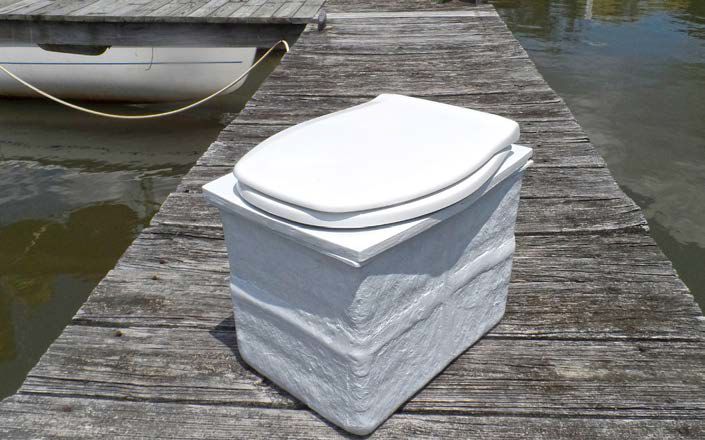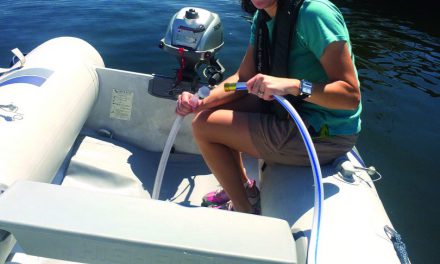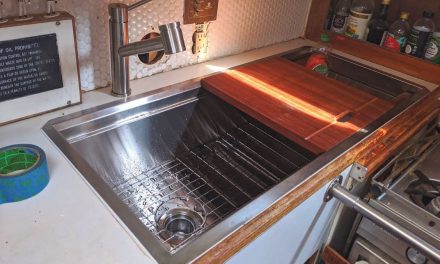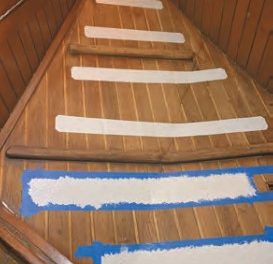A solution for smaller boats and sensitive waters
Issue 155: March/April 2024
Let’s be honest — toilets aboard small boats are tricky and can be icky. My first cruisable boat, a Stiletto 27, had a chemical toilet and I hated it. While daysailing, I was constantly lugging it ashore and often home for dumping and cleaning. On cruises, the smell made the cabin hard to live in when we had to button it up for bad weather. My next boat, a PDQ 32 cruising cat, had a conventional holding tank system, and I kept it in perfect tune. My family appreciated that it was reliable, odor-free, and effectively just like home.
Then I downsized to a Corsair F-24 trimaran, and it was back to a chemical toilet. I even tested all the new chemicals side by side in a row of improvised chemical toilets (buckets), only to learn things hadn’t gotten any better. Capacity is very limited, a few days at best. In the winter, the chemicals freeze. The toilets are heavy and my old back didn’t fancy the idea of lifting 40 pounds out of the forepeak and shuffling through the tiny cabin, up the steps, through the companionway, and across the deck — and then down the dock and to the marina toilet, if they allow that (many do not), or to home and back, which was the normal practice.
This is when I began investigating desiccating and composting toilets, which I’d been hearing about for some time. User reports were very positive, including from some friends with a sister PDQ who had swapped their marine head for an Air Head composting toilet for full-time cruising in the Caribbean. Perhaps there was something to it. I decided to dig deeper.
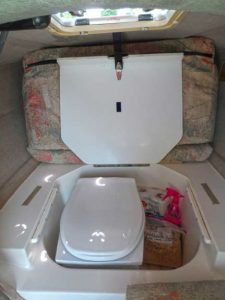
The author replaced his boat’s chemical toilet with a custom-built kit unit he made to fit the space.
Desiccating Head Basics
First off, these are not “composting” toilets in the true sense. That process takes a month at the perfect temperature, with active aeration and perfect moisture control, and six to 24 months under more ordinary conditions to produce actual compost. Instead, the goal of a desiccating toilet is to dry the waste into a form that does not smell, is more compact (the solids are actually 75% water), and is less objectionable to dispose of. The result can be composted, but the waste can also be disposed of every one to three weeks in a dumpster (we’ll come back to that). In reality, these toilets act more like a litter box in that they dry out the solids. How is it, then, that these desiccating systems don’t stink?
One central and vital feature of all desiccating heads is that they separate the solids from the liquid by means of a urine diverter (a sort of funnel) under the seat, sometimes supplemented by a sealed trap door. Urine is very high in ammonia, results in a wet mess, and triggers the odor-causing reactions in the mix.
In a desiccating head, the solids are very quickly dried on the surface by a wicking absorbent, causing a crust to form and trapping any odor inside. A thin layer of the absorbent over the waste filters and breaks down any odors that seep out. The urine goes in a separate tank, where a chemical treatment (vinegar is common) prevents it from fermenting and getting nasty. Covers and other design features further contain odors, and many units are fitted with a tiny fan, which drafts through the solids area, removing any smell and assisting with drying. That said, many users, not wanting to cut a hole in the deck, never connect the fan and report that it works fine as long as they are diligent about urine separation.
Most commercial units include a hand crank or electric mixer to blend the waste into the absorbent. The crank promotes efficient drying, thus maximizing time between services, but it can tangle with toilet paper and make cleaning laborious. With simpler units, a layer of absorbent is added on top each time it is used. With the layer type, the bucket can be lined with a plastic bag, making cleanout easy and contact-free.
The urine container will fill every few days and need to be dumped, either overboard where legal, into an onshore commode, or in the woods safely away from surface water.
I’ll only comment on units I have either used or at least worked with, since the market is growing rapidly.
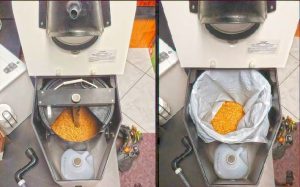
Now-defunct company C-Head’s churn and non-churn units.
What’s on the Market?
Although I eventually went down the DIY path for my small, mostly daysailed trimaran, larger, well-engineered units by Air Head and Nature’s Head offer proven, higher-capacity solutions for cruisers.
Nature’s Head and Air Head are both taller than a conventional toilet (20 inches, versus 16 to 17 inches) to accommodate the composting bin. A large solid waste bin with a hand-cranked agitator is in the back and a small urine container is in the front. The basin includes a urine separator and a closable flap over the solids bin. Both connect to a fan. The solids container can typically go two weeks between services with a crew of two, and the urine tank a few days. A challenge on many boats is the footprint, about 20 inches high and 20 inches wide, which is considerably larger than the typical marine head.
Nature’s Head recently introduced its compact Weekender toilet. The name is misleading; the holding capacity is only reduced by about 30%, so it holds over a week’s worth of waste. However, it’s only 17 inches tall (the width is unchanged), enabling it to fit in smaller boats than the original. The mechanics are the same.
Another unit, C-Head, had a small following, mostly because its smaller size fit more places. However, limited market acceptance was a challenge and the company closed soon after the inventor, Sandy Graves, passed away in 2022.
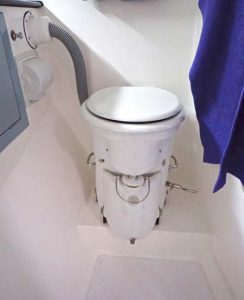
An Air Head on a Rapido 40 trimaran, which has the advantage of being a low-weight unit.
The OGO Origin, introduced in 2022, is similar in capacity and size to the Air Head and Nature’s Head, but with electric agitation and a few more bells and whistles. Whether it will prove durable is not yet known. In early 2024 the company introduced the OGO Nomad, a simple separating toilet much like the kits I describe below, without agitation and using a bag for the solids. Its smaller size (12.38 inches tall and 13 inches wide), light weight, and low price should make it competitive with kits. I might have gone that way had it been on the market four years ago.
Desiccating Head Kits
You can save a good bit of money building your own kit, but more importantly, create something to fit the exact space you have in your boat. A typical kit includes the seat and cover, an integrated urine diverting funnel, and sometimes a few bits of hose and adapters that you may or may not need. You are responsible for sourcing the waste containers and building the structure. A mixer is not included, but that can be considered an advantage, because a simple solids bucket can be lined with a bag. Service then becomes as simple as tying up the bag and replacing it with a fresh one. For a weekender like me, that sounded a lot better. Zero cleaning — just double-bag it and take it to the dumpster on the way to the car.
I picked the Separett 501 kit as the basis for my DIY head, combined with a fiberglass battery box I could modify, cheap plastic containers, and a few bits of plywood. I couldn’t have bought anything that would work better. Perfect fit, low odor, easy care. A few dollars for a urine bottle; $20 worth of epoxy, glass, and materials; a few hours of labor; and $159 for the kit on Amazon.
Free Range ($63) and The Throne ($98) sell just the diverter, so you will need to add your own seat, a minor addition. A dockmate used a Free Range kit to build his head right into an existing bench, with a hinged top.
The DIY Approach
Because no standard design would fit the space I had, I built my own toilet. I could have built the base from plywood and sheathed it in fiberglass, but I stumbled across a pair of discarded fiberglass battery boxes that I could splice together into a perfect fit. Since the exterior would not be visible, I left it unfinished and focused on a slick interior for easy cleaning. A standard 3-gallon bucket would not fit because of the reinforced rim, so I cut a 5-gallon bucket down to about 3 gallons and reinstalled the handle. In retrospect, a rectangular bucket, such as the type kitty litter is sold in, would have been an even better fit. A rectangular kitchen container with a tightly fitted lid fit the skinny space available for the urine container, and we added a filler neck and screw top salvaged from a laundry detergent bottle.
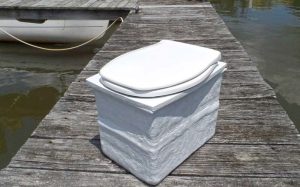
Drew used a pair of battery boxes to make the lower part. The unit would be enclosed in a well, but he wanted the toilet to have a smooth, well-finished interior.
The Separett 501 kit provided a finished-looking seat and urine diverter. I cut a cover using ¾-inch exterior plywood, sanded it thoroughly, and painted it with multiple coats of white enamel for a finished appearance. A piano hinge ensures sturdiness and easy access. A sheet of fiberglass shower surround material is placed under the seat when not in use, blocking any odors that might escape. The unit is very light, about 14 pounds fully assembled. We opted for the no-churn method, instead covering waste with absorbent material after each use. By using bags, we minimize what must be lifted out and carried, and we double-bag it as soon as it is removed.
Absorbent
Using an absorbent material to dry the waste is critical to a properly functioning system. In addition to visually covering the solids, the absorbent must also draw moisture away, allowing a crust to form. In fact, wicking ability is more important than absorption capacity, since sustained drying is the goal. Biodegradability and carbon-based bulking agents are important if the waste will be composted. Bulking materials in a compacted form are easier to store, but this can be a double-edged sword. For example, coconut coir is popular with long-distance cruisers because it comes in compressed bricks, but the downside is that the bricks must be expanded in an overnight process before they are ready to use.
Before settling on an absorbent, I tried several popular types for a week. I started with So Phresh Natural Aspen Pet Bedding shavings because that is what C-Head recommended. It comes in bags compressed to about 1/3 volume. The wicking and odor filtration were the best of the lot, but the light color does not camouflage the business as well as darker media. I tried the same company’s cedar pet bedding, but found that the cedar aroma does not help, wicking is mediocre, and cedar does not compost well (it is naturally rot-resistant).
I also tried a mix of shavings and sawdust from a local millwork shop. This was very similar to the pet bedding, and even more effective. I tried just sawdust, but it did not dry as well and was a failure. It was the same with peat moss; it has enthusiasts, but we found it messy and less effective. Next, we tried coconut coir. The dark color camouflages the waste better, the drying was pretty good, and the odor control was admirable. The blocks expand to six times their original volume, but the process takes time and can create some mess.
We tried several pet litters made from recycled paper, but they didn’t work well. We also tried some clumping litters, which were not as effective as other products and are not compostable.
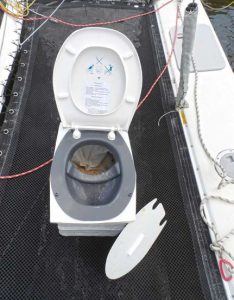
Drew used a pair of battery boxes to make the lower part. The unit would be enclosed in a well, but he wanted the toilet to have a smooth, well-finished interior.
Wood ash was recommended by a number of sites focused on sanitation for developing countries. The drying and odor control were better than anything else we tried, but it is messy to use. If we lived off-grid and had a wood burner, no question, this would be the go-to product, since its high pH and phosphorus helps with composting.
Flies can be a problem in summer, if the waste becomes too humid or is in the bucket too long. The best preventative measure is to sprinkle a little diatomaceous earth in the solids container every day. It dries the bugs out and they die. The U.S. Department of Agriculture even recommends it for livestock lots. Use about 2 cups per cubic foot of media, or ¼-cup per gallon. Once you get an infestation, and I never have, the most effective treatment is a cleanout and light spray with insecticide.
Swimming pool chlorine tabs or powder can help reduce odors. Sandy Graves of C-Head recommended suspending a small sachet of swimming pool chlorine (sodium dichloroisocyanurate) just inside of the lip of the bucket, but out of the line of fire. The dry chemical reacts with humidity in the air, releasing a slow trickle of chlorine gas, which oxidizes any odors that might still exist before they can leave the toilet. Instead of the slight musty smell that is typical, there is no odor, neither of waste nor chlorine. The chlorine reduces mildew and also seems to discourage flies. One ounce lasts two to six months, depending on humidity. Do NOT add the chemical to the media or the bucket. A small cup in a corner of the head box would also work and be easier.
Most of the commercial products are used with a fan to help speed the drying process. However, if you are careful to separate urine from solids, use an effective absorbent material, and have only one or two people on board, you won’t need it. I don’t use a fan, nor is there ventilation on the boat when we are not there.
Urine Odor Treatment
Leave a cup of urine out for a few days and it will smell worse than poo. Urine is loaded with nitrogen and potassium, and will soon ferment into something unspeakably foul. Fortunately, there are effective treatments to stop this. Although we know the chemistry, again, we turned to field testing.
Sugar helps by pickling the solution, much the way jelly is preserved. But it only delayed the process a little, and then it was even worse. A few inches of white vinegar placed in the container before use stops the fermentation process by lowering the pH. It also helps keep the ammonia from being released. We don’t care for the smell of vinegar, so we tried citric acid (add about 2 tablespoons per gallon). It is even more effective at controlling odor and better at cleaning the separator.
As with inadequately flushed urinals, scale can build up on the urine separator and become an odor source, so we keep a spray bottle filled with 1 teaspoon of citric acid per pint of water and use that as a between-use spray to keep the separator and drain clean and fresh. We also tested CLR Calcium, Lime and Rust Remover as a treatment and cleaner. Citric acid was better. However, the winner for odor control was Nilodor Bio-Enzymatic Urine Digester with Odor Neutralizer. It kills the odor without masking it.
Do not add bleach to the urine container. The hypochlorite will react with the urea, creating dangerous amounts of chloramine gas (yes, we confirmed this). Never add bleach to acid-containing solutions; chlorine gas will be released.
Disposal
Whether holding tank, chemical toilet, or desiccating toilet, there is no getting away from disposal issues. Holding tank pump-out stations are not always available, and most close for the winter. The treatments used in chemical toilets, most commonly either formaldehyde or bronopol, interfere with the biological treatment process at the wastewater plant. As a chemical engineer, I helped design a separate plant for the treatment of holding tank and chemical toilet waste for one of many cities that does not allow waste to be discharged directly to the sewer.
So where should we dispose of desiccating head solids? There have been problems with disposing of desiccated solid waste in bins next to a park bench, or too many bags in one bin. Common sense says to walk your boat rubbish and dessicated solids to the main dumpster. I am not aware of any specific federal regulation regarding small-quantity waste disposal from desiccating or composting toilets.
Home composting is another alternative. You can use the bags to transport waste home — the dried waste does not stick and will pour out cleanly. Do not use the finished compost for food crops, because human pathogens may remain unless composting takes place under very specific conditions that you will not be able to achieve. Also, be sure to control access and run-off.
As for the urine, taking the jugs ashore is simple. Many marinas forbid the disposal of portable toilet waste, but they’re talking about the blue-treated mess from chemical toilets. Many users dump the urine over the side of the boat, but EPA rules prohibit discharging sewage within 3 miles from shore, and there really is a lot of nitrogen and phosphorus in there. In remote areas, disposing in the woods well away from surface water, like a camper, is appropriate.
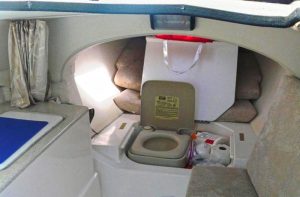
Ready for the next test cycle. Drew used kitchen bags and composted the waste during testing. Amazingly, the bags were normally completely unsoiled, with only a few traces of dry absorbent left behind. No yuck factor.
Observations
Physiology differs, and some people will find it more difficult to get waste in the right spot. It may help to urinate first, somewhat forward on the seat, and then slide back to finish. Mixed urine and solids will stink, requiring the waste to be dumped and making a fresh start. This is easier with a unit that uses a bag.
With a mix-type toilet, fill the bin with absorbent material, following the manufacturer’s instructions. Mix a few turns after each use. With the layering method, start with about 2 cups of absorbent in the bag. Cover the solids with about 1 cup of absorbent before adding toilet paper, and then another cup of absorbent after. There’s no harm in using more. It will just fill the bucket sooner, but you will discover that you need less than you think.
Alternatively, you can place toilet paper in a separate zip-close bag to save space in the head. Less absorbent material is required, and the desiccation will dramatically reduce the waste volume. We found that a 3-gallon bucket will last one person about 10 days, toilet paper and all, assuming the toilet is used exclusively. A 5-gallon bucket should easily last two people one week. If toilet paper is disposed separately, it will last two to three times longer and smell slightly less because the cover is more efficient. We tested both ways and concluded it comes down to personal preference and needs.
Spray the urine diverter with citric acid or Nilodor solution after each use to keep it clean and fresh.
We don’t leave waste in the toilet if we are going to be away for more than a few days. It’s simple to pull the bag and dump the jug. Others leave it until full. If you do that, I recommend adding some absorbent and extra urine treatment.
Venting can help, but it is generally not needed if the container is sufficiently dry. Following that thread, we experimented with keeping a container of calcium chloride or silica gel absorbent cylinders in the enclosure, but not in the bucket itself. That seemed to help, since the drier the absorbent and the deposits, the less potential for smell. But do not add desiccant (silica gel or calcium chloride) to the bucket; we are trying to pull water out of the bucket, not draw it in. This is why we use a cover material (absorbent) with superior wicking characteristics.
We’re still fans of a well-installed and well-maintained conventional head and holding tank system for cruising boats. At the beginning of our exploration, we didn’t expect much of the whole idea of drying or composting waste, but at least for some boats and some situations, we were wrong. Some areas lack pump-out stations, or those facilities might close in the winter. Perhaps your boat is very small, or you mostly daysail and don’t use a conventional head enough to justify the maintenance. Fortunately, the alternatives to a conventional head have increased in recent years. There are new, smaller units on the market. There are kits, particularly well suited to custom fitting requirements.
We swapped from a chemical toilet to a kit-built desiccating toilet and would never go back. The benefits are numerous. You’ll never clog the head again. The hoses won’t permeate, the vent won’t clog, and you needn’t rely on the pump-out station to have good suction. You don’t need to flush with antifreeze in the winter. These are all positives.
Good Old Boat Technical Editor Drew Frye draws on his training as a chemical engineer and pastimes of climbing and sailing to solve boat problems. He cruises Chesapeake Bay and the mid-Atlantic coast in his Corsair F-24 trimaran, Fast and Furry-ous, using its shoal draft to venture into less-explored waters. He is most recently the author of Rigging Modern Anchors (2018, Seaworthy Publications).
Thank you to Sailrite Enterprises, Inc., for providing free access to back issues of Good Old Boat through intellectual property rights. Sailrite.com

